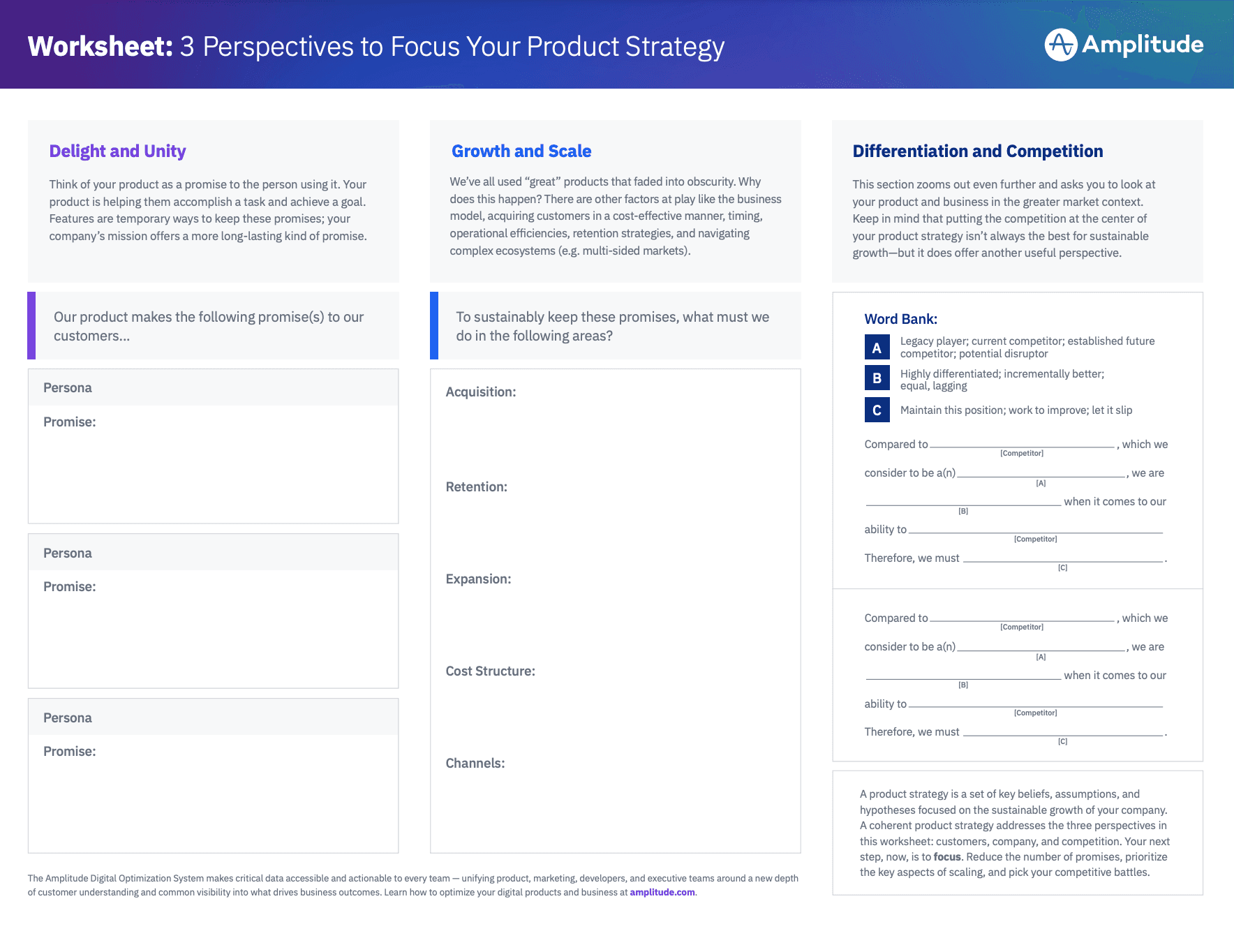Product Strategy Template: Focus Your Efforts With These 3 Steps
Building a product strategy is an overwhelming, highly dynamic process. Get off to a great start in creating your product strategy with our free template.
Building and executing a product strategy is difficult, to say the least. Forty-five percent of all products fail to launch on time, while 20% of that number fail to meet internal targets.
The key to overcoming those statistics is the expectations that your team places upon your product strategy itself. Ask yourself: “What are the intangible outcomes we’ll strive for, by implementing this strategy?” An effective product strategy template will keep you focused on the fundamentals and not bogged down in unnecessary particulars. It should prompt you to plot where your product will deliver value, how it will grow, and what it has to do to stand out from the pack.
If you’re looking for a ready-made template to download and get working on straight away, head here to download yours for free. You can see what your free download will look like, below. This worksheet is also included in The Product Strategy Playbook: A Guide to Flywheels.
Looking for a bit more guidance? Read on to find out how to shape your product strategy template to give your team the mixture of discipline and freedom needed to build great products.
Step 1: Determine how you will delight your buyer
Our product strategy template will first ask you to identify how your product is helpful to buyers. If you can’t answer this question, then your product’s unique selling position (USP) needs some refinement. If you can clearly point out where your product provides delight and utility to users, then your product strategy is off to an ideal start.
Figuring out delight and utility is not the same thing as planning out your features. Features will change across the product development cycle. It’s unlikely that many of the features you think of at first will make it into your final product. On top of that, having a too-rigid set of proposed features will make your product strategy less flexible. Complete your product strategy template before you begin shaping your aims and analysis into useful features.
Instead, think of your answer to the question as a promise to your users about how you will help them accomplish their tasks and achieve their goals. To that end, begin with your buyer personas, and think of your product’s usefulness to them carefully.
For example, a company strategizing a productivity tool might approach customer delight and utility like so:
- Personas: Begin your product strategy with a grasp of your persona(s). For example, this productivity tool company might plan to target SaaS professionals initially.
- Needs: Articulate what needs you are satisfying with your product. The primary for the productivity tool’s target persona could be maintaining a solid work-life balance during the remote working period.
- Product Utility: Link your product features to your persona’s needs. The productivity tool might help their persona by estimating how long each of their day’s tasks will take, based on a user’s pace of work. It will help them plan better and be more productive while avoiding burnout and long days.
You know that you understand your product when you can express its purpose simply. Once you can articulate your personas, needs, and product utility in a couple of lines each, you’re ready to move on.
Step 2: Plan how your product will grow and scale over time
The second part of our product strategy template is understanding how your product strategy aligns with plans to grow and scale the company. The pure utility of your product is not enough; we’ve all used “great” products that ultimately fell into obscurity through inability to scale their operations. A powerful product strategy doesn’t just meet customer needs—it helps the company expand over time.
Figuring out how to grow your company is a key part of keeping that early promise to your customer. Plan to scale according to the following steps.
Acquisition
Your product needs to be able to acquire customers cost-effectively. To that end, your product strategy needs to feature steps concerning how you will go about customer outreach, how much budget you can reserve for acquisition, and how your product will be designed to shorten the distance between customer acquisition and adoption.
Retention
Your product needs to consistently offer value so people are motivated to use it regularly, leading to retention. Because retention is so central to the SaaS revenue model, it’s vital to the rest of your product strategy. Consider how you will go about structuring upsell packages, how you’ll design your product to promote regular use, and what retention rates you need to target to remain profitable.
Expansion
Most products start within a small, well-defined market segment, but your strategy should also consider how your product will expand beyond that segment. Make a list of other sectors, ordering them by how straightforward they will be to penetrate, and how much ARR (Annual Returning Revenue) you predict that each will yield on average. Consider what adjustments you may need to make to your offering to make it more attractive to potential future industry segments.
Cost Structure
Product development incurs a number of costs that you need to account for in your strategy. Your initial development costs will include the following:
- External resources: Anything your company will need to invest in that it doesn’t already have, such as freelancers or data sets.
- Maintenance costs: Costs relative to keeping your product functioning, such as maintaining the security of your product and its data and developing patches and updates.
- Marketing spend: While not specifically the responsibility of your product development team, having a sense of how to position your product in the market will be helpful in helping your product stay competitive. This can involve an understanding of your channels (e.g., your product may have to penetrate multi-sided markets with more than one customer set) and tone.
You’ll need to balance these anticipated expenses against revenue projections in order to make sure your product is financially viable. If you find that your product is going to be more expensive than you first thought, you may need to adjust your product strategy to aim for higher yield industry sectors.
Step 3: Differentiating your product from the competition
The final part of your product strategy template is figuring out what differentiates your product from existing items and services in the market. Differentiating your product is not just a case of comparing your product’s USP against competing products’ USPs. It also involves assessing where your company sits relative to competing companies.
Categorize your competition according to three considerations:
- A) The size of the opposing business. All of your opposition will fit into one of the following categories:
- Legacy competitor: A household name in the same field. They have tremendous trust and credibility, good cash runway, and a reliable product.
- Current competitor: A company that is scaling smoothly and is well-established but may not yet be a household name.
- Established future competitor: A company with a viable product that may not be in scale-up phase yet but has solid backing and business coming in.
- Potential disruptor: A company on the rise, with an innovative product.
- B) How your company compares in size/output/technological advancement:
- Highly advanced: It’s doubtful that you could compete with this competitor’s technological pedigree.
- Somewhat advanced: This competitor’s tech is a few levels up, but nothing your product couldn’t match with the right investment.
- Equal: There is no meaningful difference between your state of advancement and this competitor’s.
- Lagging: This company’s lower level of technological investment and advancement will prevent them from being competitive to the highest degree.
- C) The course of action required to make up ground on this competitor. Deciding your course of action involves a holistic appraisal of factors A and B:
- Maintain this Position: Your current level of investment and the degree of your product’s differentiation will be sufficient to make your product competitive with your competitor’s.
- Work to Improve: You face falling behind this competitor if things stay as they are. You must work to improve in your current areas of deficiency.
- Can Let Slip: You can afford to ignore this competitive difference, because it is not likely to impact your business direction (and thus product strategy).
You can then build a rubric for neatly summarizing where you compare your product to specific others. For example:
- “Compared to [Competitor 1], which we consider a legacy competitor, we are somewhat advanced when it comes to our technology. Therefore, we should expect to maintain this position within [timeframe x], allowing us to overtake them in the market.”
An alternative version of this schema might go like this:
- “Compared to [Competitor 2], which we consider a potential disruptor, we are lagging when it comes to the breadth of our product’s appeal. We should therefore work to improve within [timeframe x], so that they don’t overtake us.”
It’s important that you don’t put market competition at the center of your product strategy. You should develop your product according to your unique impression of user needs, not based on impressions of what your competitors are doing. Nevertheless, having a solid grasp of the state of competition can help you orient your ambitions effectively, plan more competitive feature bundles, and make more cost-effective estimations of acquisition spend.
Download Your 3-Step Product Strategy Template Now
Our product strategy template will help your product team focus on the fundamental aspects of development so no one overlooks critical steps in the excitement to get your sparkling new product to market. Combine that with a solid grasp of context and great product analytics and you’ll be well on your way to something special.
Download your product strategy template here.
Be prepared to update your product strategy as needed. Plan regular product strategy reviewing sessions, and be flexible on small details as you progress. With room to maneuver, you’ll be able to iterate on your product as new user insights appear.

Sam Edwards
Former Global Technology Partner Manager, Amplitude
Sam is a global technology partner manager at Amplitude and former solutions engineer and customer success manager. She specializes in helping businesses reach their revenue goals, scale for growth, and build the best product for their users.
More from Sam






